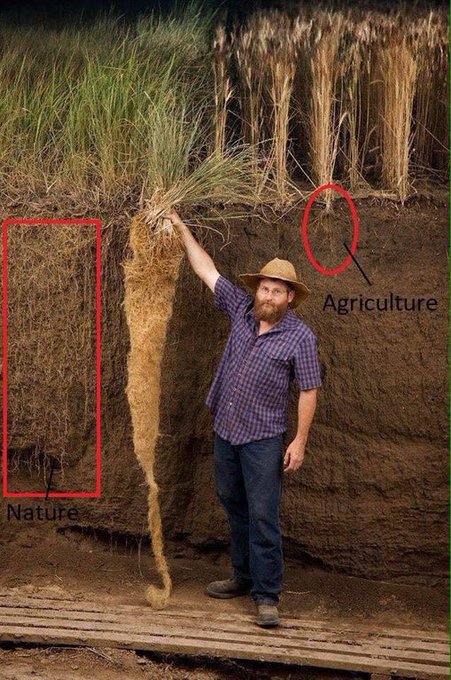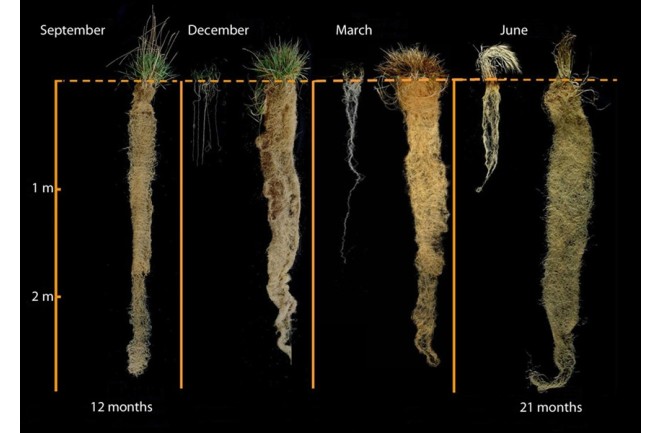A leading researcher spills the beans on potentially sustainable agriculture for the world’s growing population.
By 2050, there will be more than 9 billion people on the planet. They’ll have to eat somehow, but we’re already out of arable land. Many types of agriculture, including conventional farming of annual crops that must be replanted each year, leave fields depleted of nutrients, reducing future productivity.

But Jerry Glover, a soil scientist, is optimistic about feeding more people while conserving farmland soil. He believes that the solution is to focus less on annual crops, which dominate global agriculture, and more on the potential of perennials, crops that can be harvested multiple times without replanting.
Glover, a senior sustainable agricultural systems research adviser at the United States Agency for International Development (USAID), previously worked as a researcher at the Kansas Land Institute. He realized there that the state’s perennial grasses might hold the key to soil conservation, reduced fertilizer use, and multiple harvests from a single plant.
Glover discovered that farming could have a neutral, even positive, impact on the agricultural ecosystem. Glover, 48, was named one of five “crop researchers who could change the world” by Nature in 2008. Discover spoke with Glover about his plans for doing so.
Discover: Did your upbringing on a farm in drought-prone eastern Colorado shape your professional perspectives?
Mr. Jerry Glover: Conditions there undoubtedly had an impact on me. I was witnessing agriculture’s massive soil devastation. But I also saw agriculture’s potential and need. I believe we must now examine how our civilization has evolved at the expense of the soil resource.
What do you believe the most harmful effects of conventional agriculture are?
JG: When farmers harvest their crops, they extract nutrients from the soil. Some nutrients are also lost on the farm due to runoff — more than half of the nitrogen applied to wheat crops is lost before harvest. That loop must be closed. One of the most significant opportunities is to ensure that the nutrients we return to the farm remain on the farm and are utilized by the plants.

Most farmers grow annual crops that must be planted each year.
However, during your research, you discovered that perennial grasses could be harvested repeatedly to make hay with little added fertilizer and without depleting soil nutrients like nitrogen and phosphorus.
Is it possible that perennial food crops will be the answer to feeding the world in the coming decades?
JG: I believe they are. Perennial crops can be grown for more than two years, either alone or in conjunction with annuals, and they can significantly improve soil health and support a healthier underground community of bacteria and fungi.
Annuals must develop roots every year, resulting in a much shorter growing season. Perennial roots grow deep — some as deep as 10 feet — and will keep the plant alive for many years. The roots can capture more groundwater down there. Deeper, more established roots also aid in the cycling of nutrients in the soil, making them more available to plants.
And, of course, the most important [benefit of perennials] is that they prevent soil erosion. Water will soak in rather than run off with better soil conditions. Perennials also cover the soil with plant material for a longer period of time. As a result, when it rains, the leaves and stems intercept it and reduce its impact. This reduces the likelihood of soil loss due to runoff.

Farmers all over the world are beginning to experiment with perennial food crops, including grains such as wheat and sorghum, as well as legumes such as peas and beans.
But why did it take so long? If perennials are so wonderful, why haven’t farmers bred them yet?
JG: The first plant breeders were farmers who were primarily concerned with crop yield in the first year. And they certainly did not have the same awareness of some of the negative effects of agriculture that we do now because they were not constrained by land or resources. There was no massive population pressure like we have now.
We also have much better plant breeding tools now. We now have much more powerful, faster computers that can sift through genetic material to determine which traits will be more productive. And we urgently need to increase food productivity. It’s a perfect storm of opportunity and difficulty.
Where should perennial crop research and development priorities be prioritized, at least in the short term?
JG: Given the protein requirements of many developing countries, I recommend focusing first on perennial legumes. The main advantage is that legumes contribute to cropping systems by removing nitrogen from the atmosphere and making it available in the soil. Perennial sorghum and rice are also very promising and could be available in the near future. My organization, USAID, has given money to the University of Georgia to research perennial sorghum.

You’re now primarily concerned with encouraging farmers all over Africa to plant perennial crops that will feed people while also improving soil health. Is the soil there in worse condition than in North America?
JG: African soils have always been less fertile and less well-suited to agricultural production than American soils. Farmers in Africa are frequently confronted with the significant challenge of working with inherently old, highly weathered soil. Their soils have also been heavily eroded by this point. As a result, we require immediate and significant improvements in this area.
Where have you seen perennial crops thrive?
JG: I recently visited a system in Malawi [in southeastern Africa] where pigeon peas, which can be grown as an annual or perennial crop, are grown alongside annual soybeans. After harvesting the soybeans and pigeon peas, the pigeon peas are allowed to regrow. Maize is planted into the pigeon peas when they are regrowing. Previously, farmers would have grown only maize or rotated maize with soybeans, but with this system, they now get two harvests of legumes in one season — pigeon peas and soybeans — and then a harvest of maize and pigeon peas in the second season.
So they’re significantly increasing the amount of protein they grow on their farm, which is valuable both in terms of household nutrition and market value. From my perspective as a soil scientist, it also adds a lot of benefits to soil.
What are some of the barriers to more African farmers growing perennials?
JG: Pigeon peas are already widely grown, but primarily as annual crops. Their long-term benefits could be much more widely utilized. The main barrier to the adoption of other crops is a lack of plant breeding to sufficiently improve perennial wheat and sorghum and test them in farmers’ fields.
Do you believe perennial crops can be valuable and useful in the developed world as well?
JG: I believe they will be more productive than our annual grain crops in the long run because they can capture more sunlight, water, and nutrients. However, there is no sense of urgency in developed countries. The political will, or support from the farm community, is probably not as strong.






